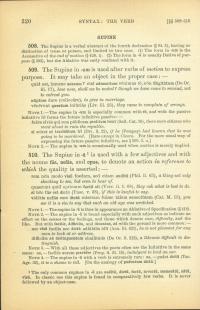508. The supine is a verbal abstract of the 4th declension (§ 94.b), having no distinction of tense or person, and limited to two uses. (1) The form in -um is the Accusative of the End of Motion (§ 428.i). (2) The form in -ü is usually Dative of Purpose (§ 382), but the ablative was early confused with it.
509. The supine in -um is used after verbs of motion to express purpose. It may take an object in the proper case.
Quid est, īmusne ses sum? Etsī admonitum vēnimus tē, nōn flāgitātum. (De Or. 3.17)
How now, shall we be seated? Though we have come to remind, not to entreat you.
nūptum dare (collocāre)
to give in marriage
Vēnērunt questum iniūriās. (Liv. 3.25)
They came to complain of wrongs.
Note 1— The supine in -um is especially common with eō, and with the passive infinitive īrī forms the future infinitive passive.
Fuēre cīvēs quī rem pūblicam perditum īrent. (Sall. Cat. 36)
There were citizens who went about to ruin the republic.
sī scīret sē trucīdātum īrī (Div. 2.22)
if he (Pompey) had known that he was going to be murdered
[Rare except in Cicero. For the more usual way of expressing the future passive infinitive, see § 569.3.a.]
Note 2— The supine in -um is occasionally used when motion is merely implied.
510. The supine in -ū1 is used with a few adjectives and with the nouns fās, nefās, and opus, to denote an action in reference to which the quality is asserted.
rem nōn modo vīsū foedam, sed etiam audītū (Phil. 2.63)
a thing not only shocking to see, but even to hear of
Quaerunt quid optimum factū sit. (Verr. 2.1.68)
They ask what is best to do.
sī hōc fās est dictū (Tusc. 5.38)
if this is lawful to say
Vidētis nefās esse dictū miseram fuisse tālem senectūtem. (Cat. M. 13)
You see it is a sin to say that such an old age was wretched.
Note 1— The supine in -ū is thus in appearance an Ablative of Specification (§ 418).
Note 2— The supine in -ū is found especially with such adjectives as indicate an effect on the senses or the feelings, and those which denote ease, difficulty, and the like. But with facilis, difficilis, and iūcundus, ad with the gerund is more common.
Nec vīsū facilis nec dictū adfābilis ūllī. (Aen. 3.621)
He is not pleasant for any man to look at or address.
difficilis ad distinguendum similitūdō (De Or. 2.212)
a likeness difficult to distinguish
Note 3— With all these adjectives the poets often use the Infinitive in the same sense.
facilēs aurem praebēre(Prop. 2.21.15)
indulgent to lend an ear
Note 4— The supine in -ū with a verb is extremely rare.
Pudet dictū (Tac. Agr. 32)
It is a shame to tell.
[On the analogy of pudendum dictū.]

